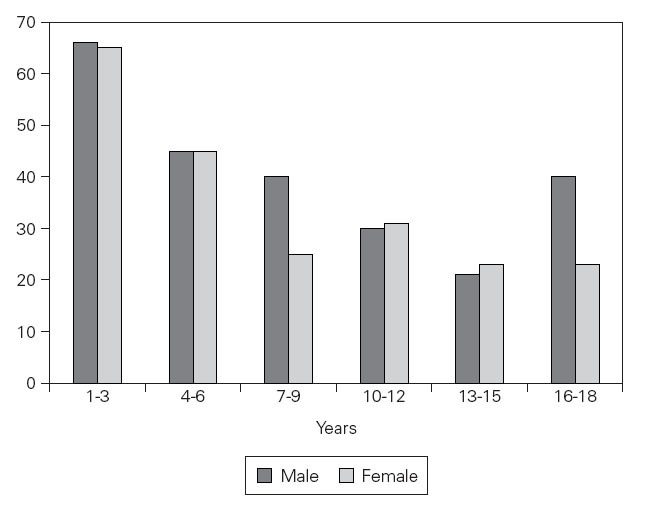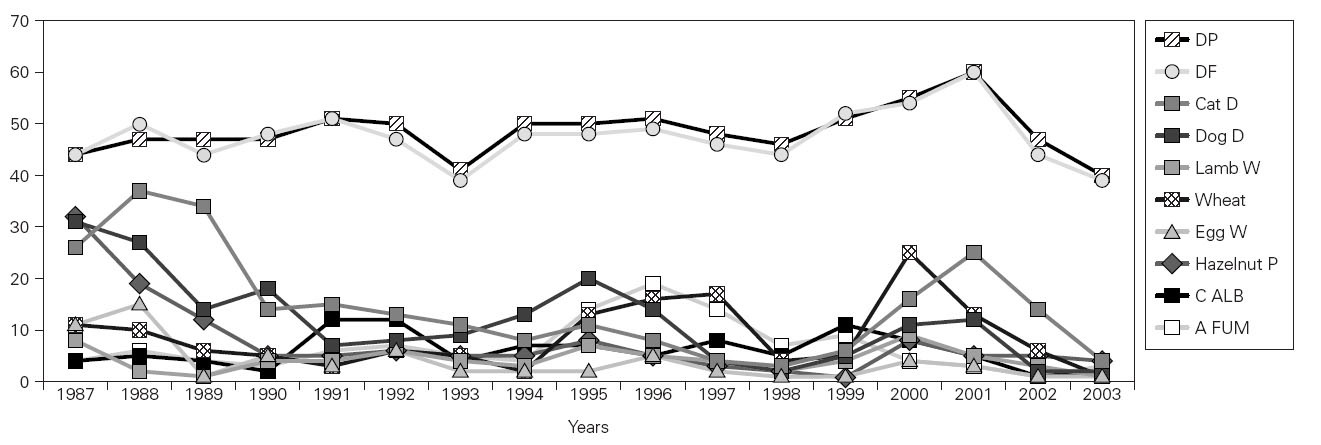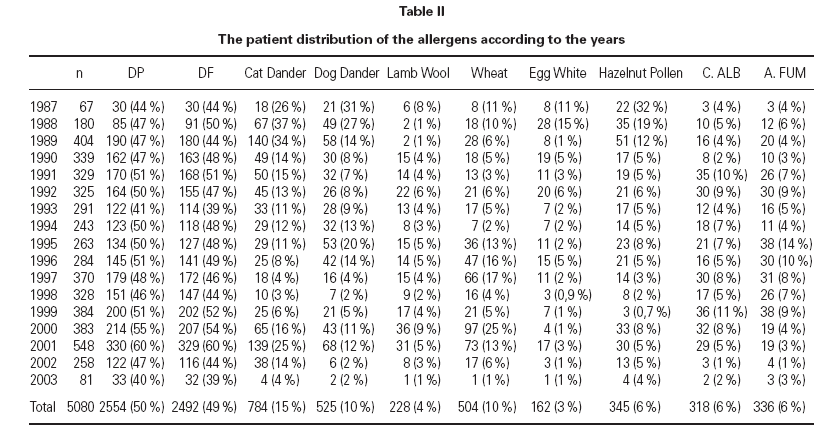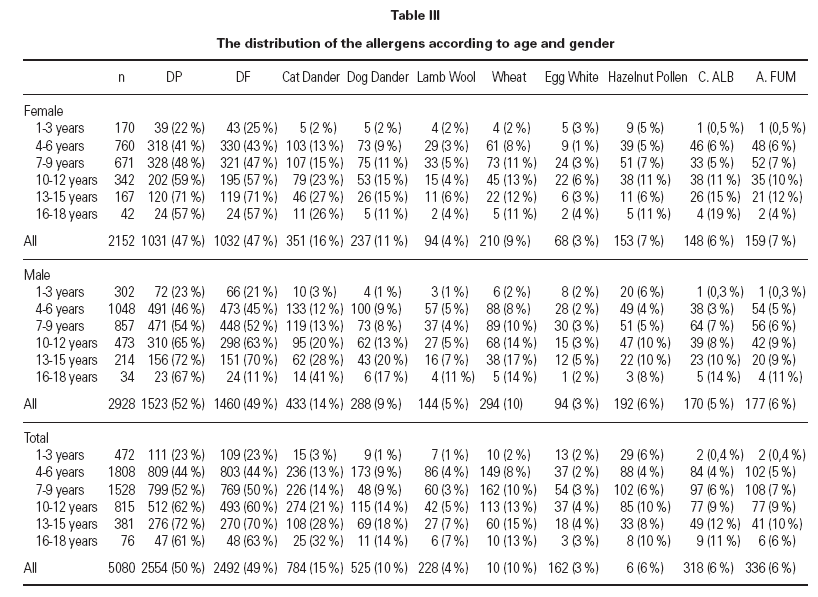INTRODUCTION
Asthma is a leading cause of chronic illness in childhood. Epidemiological studies report an increasing prevalence especially for childhood asthma in recent years 1-3 . This is the result of many in and out household factors.
Skin prick test (SPT) which is an in vivo laboratory test used to diagnose asthma and allergic disorders, is a type I hypersensitivity reaction, mediated by IgE, which occurs when small amounts of extracts of test antigen is introduced into the skin of sensitive people by scratch, puncture or intra dermal techniques. In this series of biochemical reactions, many pharmacologically active substances (such as histamine), known as chemical mediators, are released when the test allergen bridges adjacent IgE molecules, which is reversibly bound or “fixed” to surface receptors of mast cells and basophiles and leads to the known initial wheal and flare reaction (induration plus surrounding edema and erythematous swelling, occurring at the injection site 15 minutes later), which is replaced by an inflammatory lesion 6-12 hours later. Skin prick test is an easy test to apply, inexpensive and sensitive and is also little traumatic. Nowadays SPT has a widespread usage, as it has besides some benefits like avoiding exposure with the known allergen and also preventing from exposure to environmental factors in childhood asthma, it provides immunotherapy for selected cases. In this study we retrospectively screened the age and gender prevalence of our cases, as 10 frequently exposed allergens were introduced to each of our patients, for a period of 16 years, in Istanbul and their changes within these years.
MATERIALS AND METHODSAll consecutive 5080 asthmatic children, aged 1 to 18 years, admitted to Pediatric Allergy Policlinics of Istanbul University Cerrahpasa Medicine Faculty from 1987 January to 2003 April, were screened retrospectively. After cleaning the interior faces of the forearms of all cases, 10 frequently exposed allergenic solutions ( Dermatophagoides pteronyssinus [DP], Der matophagoides farinea [DF], cat dander, dog dander, lamb wool, wheat, egg white, hazelnut pollen, Candida albicans and Aspergillus fumigatus ), histamine for positive control and serum physiologic for negative control were introduced into the skin by prick method in the mornings by the same health personnel.
Patients were warned not to use antihistamines at least 20 days before the test and an asymptomatic period is chosen. For our study if the radius of the enduration formed 15 minutes after the injection was 3 mm and over 3mm, it was accepted as a positive respond 4,5 .
RESULTSA total of 5080 cases, 2152 girls (42 %) and 2928 boys (58 %), with documented childhood asthma, aged 1 to 18 years (mean 6.3 years), admitted to Pediatric Allergy Policlinics of Istanbul University Cerrahpasa Medicine Faculty, were screened for skin test hypersensitivity against 10 allergenic extracts introduced epidermal with prick method.
There wasn’t any reactivity against skin test in 1994 cases (39 %) retrospectively screened (table I).
In the SPT negative group 887of the cases (17%)were female and 1107(22%) were male. When thecases without sensitization to SPT were screenedaccording to age ranges, 312cases (66%) were 1to3years of age, 824cases (45%) were 4to 6yearsof age, 495cases (32%) were 7to 9years of age,252cases (30%) were 10to 12years of age, 86cas-es (22%) were 13to 15years of age, 25cases(32%) were 16to 18years of age (fig.1). When10allergenic extracts introduced were screened ac-cording to the age ranges of boys and girls; the leastsensitivity to all of the 10allergens was in the 1to3years of age range (for girls 66% and for boys65%, in sequence) and sensitivity increased with in-creasing age for childhood asthma (fig.1) (tableI).When we screened the age and years of 3086cases (61%) having reactivity to at least one anti-genic extract, house dust mites were reported as themostly encountered positive allergen in comparisonwith other allergens, during a period of 16years(fig.2) (tableII). Also house dust mites were fre-quently positive for all age groups (tableIII).
When we screened the age and years of 3086cases (61%) having reactivity to at least one anti-genic extract, house dust mites were reported as themostly encountered positive allergen in comparisonwith other allergens, during a period of 16years(fig.2) (tableII). Also house dust mites were fre-quently positive for all age groups (tableIII).When the allergen exposure distribution of ourcases were screened, DP (50%, 2554cases) and DF(49%, 2492cases) were the mostly exposed anti-gens (tableIII). As cat dander was 15% (784cases)positive, it was the frequently exposed 3rdallergen.The positive hypersensitivity percentages to otherallergens were; dog dander 10% (525cases), lambwool 4% (228cases), wheat 10% (504cases), eggwhite 3% (162cases), hazelnut pollen 6% (345cas-es), C. Albicans 6% (318cases), A. Fumigatus 6%(336cases) (tableII).When we screened according to age ranges, forall age ranges hypersensitivity to house dust miteswas the most (fig.3). The allergen hypersensitivitypercentages for boys and girls were reported to bealmost similar (tableIII).
Figure 1.—The age distribution of our cases without having posi-tive reactivity to the skin tests (%).
Figure 2.—The distribution of the allergens according to the years (%).
DISCUSSION
Allergy has an important role for asthma develop-ment and allergic factors are responsible for 80% ofchildhood asthma. Aeroallergens trigger asthma andasthma attacks frequently than the ingested aller-gens.Skin prick test helps to define the etiology of oneof the chronic inflammatory diseases, asthma, thathas an increasing prevalence for childhood and helpsboth in preventive therapy and in immunotherapy,so it is one of the important in vivolaboratory tests.Although most suitable SPT application time is notknown exactly, positive reactivity can be in earlychildhood, at 1year of age6. In our study, skin reac-tivity couldn’t be observed in 66% of asthmatic chil-dren aged3years. However, 34% positive reac-tivity has a diagnostic importance, thus SPT is usefulin childhood allergic disorders.
Table I Age and gender distribution of our cases without having positive reactivity to the skin tests
Table II The patient distribution of the allergens according to the years
Table III The distribution of the allergens according to age and gender
Skin prick test negativity in the earlier ages was higher than the other age groups of our patients. Skin prick test negativity of our cases was in 1994 patients (39 %) and was both in girls and boys (66 % and 65 %, in sequence), and was mostly in children aged 1 to 3 years. In girls in the age ranges of 7 to 9 years and 16 to 18 years allergy test negativity was found to be higher than the boys (table I).
Prevalence of asthma and allergens detected by SPT, change from country to country and also from region to region. Thus house dust mites are the allergens mostly detected in asthmatic patients 7-10 .
In our study, positive reaction to at least one allergen was detected in our 3086 patients (60 %). We have introduced five groups of allergenic extracts; these are house dust mites, animal allergens, food, pollen and fungus and from these the predominant reaction was against to house dust mites.
In Istanbul, which is one of the greatest metropolitan cities, positive reaction to house dust mites has reached to the highest level during 2001. Nowadays, decrease in hypersensitivity since 2001, can be attributed to the periodic instruction provided to the society by educating about the preventive measures against house dust mites with the help of written and visual media like newspapers, radio and television and also by education institutes.
Cats are domestic animals frequently kept in our homes since old years. Positive SPT reaction to cat dander has incrementally decreased when compared with the earlier years, but have reached a peak level during 2001 and also have been at this same level during the earlier years. As lamb is a domestic animal that is kept at rural regions, the low detection rate of allergic hypersensitivity to lamb wool is attributed to the low probability of exposure.
When we screened wheat and egg white that are the frequently ingested foods during childhood, although wheat had different positive reaction rates in different years, the positive reaction against the white part of the egg had decreased as child grow up. Thus, wheat and the egg white aren’t important allergens for childhood asthma. Although there haven’t been different positive reaction rates against fungus in different years, by improved living styles their rates have been decreasing with years.
Istanbul and its neighborhood provide the most suitable conditions for the house dust mites to live and to multiply. In our study, in parallel to this, we detected that the sensitivity to the house dust mites had been at the highest level.
Correspondence:
N. AkcakayaProfessor of Pediatrics Infectious Diseases. Clinical Immunology and Allergy Division. Department of Pediatrics Cerrahpasa Medical Faculty University of Istanbul. Turkey E-mail: makcakaya@superonline.com














